PDF Version
Key Small Business Statistics - August 2013
844 KB, 29 pages
- Foreword
- Highlights
- Number of Businesses
- Employment
- Survival
- Growth
- Innovation
- Exports
- Contribution to Gross Domestic Product
- Business Owner Characteristics
- Concluding Remarks
Foreword
Key Small Business Statistics is an annual publication that provides baseline data on the small business sector in Canada. This nineteenth edition updates data found in previous editions and introduces some new sections.
The following sections have been updated with new data:
- How many businesses are there in Canada?
- How many people work for small businesses?
- How many jobs do small businesses create?
- How many businesses appear and disappear each year?
- Bankruptcy statistics
- What share of firms are high-growth firms?
- What is the contribution of small businesses to Canada's exports?
- What is the contribution of small businesses to Canada's gross domestic product?
- How many small business entrepreneurs are women?
The following sections are new:
- How much do small businesses innovate?
- What are the age, experience and education levels of small and medium-sized business owners?
Notes on data and statistics:
- Previous editions of this publication featured data from Statistics Canada's Survey of Employment, Payrolls and Hours split by enterprise size. In an effort to gain consistency throughout the report and publish employment data at the establishment level, Statistics Canada's Labour Force Survey was chosen as a more suitable data source for this publication.
- Statistics on self-employment are no longer part of Key Small Business Statistics.
Highlights
Number of Businesses
- As of 2012, there were just over 1.08 million small businesses in Canada that had employees (excludes self-employed entrepreneurs and indeterminate businesses). Ninety-eight percent of businesses in Canada have 1 to 99 employees.
- Taking into account entries and exits, the net increase in the number of small businesses was almost 22,000 over the 2008–2009 period.
Employment
- As of 2012, small businesses employed over 7.7 million individuals in Canada, or 69.7 percent of the total private labour force.
- Small businesses created a little over 100,000 jobs, on average, between 2002 and 2012, accounting for almost 78 percent of all private jobs created on average.
Survival
- Survival rates for small and medium-sized enterprises in Canada decline with time. About 80 percent of enterprises that entered the marketplace in 2008 survived for one full year and 72 percent of enterprises that entered the marketplace in 2007 survived for two years.
- The number of business bankruptcies in Canada fell by 56 percent between 2000 and 2010 to about 3,200 in 2012.
Growth
- High-growth firms are present in every economic sector and are not just concentrated in knowledge-based industries. In terms of employment, the highest concentrations of high-growth firms in Canada during the 2006–2009 period were in construction (4.9 percent of all firms); business, building and other support services (4.6 percent); and professional, scientific and technical services (4.5 percent).
- Over 50 percent of firms in both the manufacturing and service-producing sectors expect to grow between one and ten percent from 2012 to 2014.
Innovation
- In 2009, small businesses accounted for 31 percent of total research and development expenditures, spending $4.8 billion.
- From 2009 to 2011, the highest percentages of small and medium-sized enterprises that innovated were found in manufacturing; knowledge-based industries; and professional, scientific and technical services.
Exports
- In 2011, only 10.4 percent of small and medium-sized businesses exported. Nonetheless, they were responsible for $150 billion, or about 41.0 percent, of Canada's total value of exports.
Contribution to Gross Domestic Product (GDP)
- As of 2008, depending on various estimates, small businesses contributed between 25 and 41 percent to Canada's GDP.
Business Owner Characteristics
- In 2011, almost 14 percent of small businesses were solely owned by females, while over 18 percent were owned in equal partnerships between male and female owners.
- In 2011, almost 50 percent of all small and medium-sized enterprise owners were between 50 and 64 years of age, and over 77 percent of business owners had more than 10 years of experience.
How do we define and categorize businesses?
The term "business" refers to registered business establishments. To be included in our sample population, a business establishment must meet one of the following criteria: have at least one paid employee (with payroll deductions remitted to the Canada Revenue Agency (CRA)), have annual sales revenues of $30,000, or be incorporated and have filed a federal corporate income tax return at least once in the previous three years. As Industry Canada uses a definition based on the number of paid employees in this publication, our analysis excludes the self-employedFootnote 1 and "indeterminate"Footnote 2 businesses. Also excluded from the sample population are businesses in the following industrial sectors: public administration, including schools and hospitals; public utilities; and non-profit associations.Footnote 3
The size of a business establishment can be defined in many ways: annual sales or shipments, annual gross or net revenue, assets or number of employees. Among these measures, the approach using the number of employees to determine the size of businesses is widely used to categorize businesses. Data for this measure are often easiest to collect from surveyed businesses and help to facilitate cross-country comparisons. Accordingly, in this report, an SME is a business establishment with 1–499 paid employees, more specifically:
- A small business has 1 to 99 paid employees.Footnote 4
- A medium-sized business has 100 to 499 paid employees.
- A large business has 500 or more paid employees.
How many businesses are there in Canada?
As of December 2012, there were 1,107,540 employer businesses in Canada, as shown in Table 1, of which 1,087,803 were small. Small businesses make up 98.2 percent of employer businesses, medium-sized businesses make up 1.6 percent of employer businesses and large businesses make up 0.1 percent of employer businesses.
| Provinces/ Territories | Employer Businesses | No. of Small and Medium-Sized Business Locations per 1,000 Population (aged 15+ years) | GDP per Employer Business ($ thousands) | |||
|---|---|---|---|---|---|---|
| Total | Small (1–99) | Medium (100–499) | Large (500+) | |||
| Source: Statistics Canada, Business Register, December 2012; National Income and Expenditure Accounts 2010; Labour Force Survey (LFS), 2012. Note: LFS working age population (aged 15 years and above) estimates are available for provinces only. | ||||||
| Newfoundland and Labrador | 17,335 | 17,090 | 233 | 12 | 40.5 | 1,940 |
| Prince Edward Island | 5,615 | 5,547 | 64 | 4 | 46.6 | 953 |
| Nova Scotia | 29,686 | 29,179 | 468 | 39 | 38.0 | 1,247 |
| New Brunswick | 24,992 | 24,582 | 386 | 24 | 40.3 | 1,288 |
| Quebec | 236,688 | 232,531 | 3,830 | 327 | 35.6 | 1,461 |
| Ontario | 389,116 | 381,001 | 7,437 | 678 | 35.2 | 1,682 |
| Manitoba | 35,980 | 35,298 | 622 | 60 | 37.4 | 1,553 |
| Saskatchewan | 38,749 | 38,264 | 457 | 28 | 47.8 | 1,929 |
| Alberta | 154,495 | 151,866 | 2,397 | 232 | 50.3 | 1,911 |
| British Columbia | 171,557 | 169,178 | 2,218 | 161 | 45.0 | 1,269 |
| Yukon | 1,568 | 1,549 | 18 | 1 | n/a | 1,696 |
| Northwest Territories | 1,294 | 1,263 | 29 | 2 | n/a | 3,702 |
| Nunavut | 465 | 455 | 10 | 0 | n/a | 4,224 |
| Canada Total | 1,107,540 | 1,087,803 | 18,169 | 1,568 | 39.0 | 1,591 |
| Percentage | 100.00 | 98.22 | 1.64 | 0.14 | ||
Approximately 57 percent of all employer businesses in Canada are located in Ontario and Quebec. Virtually all the rest are divided between the western provinces (36 percent) and the Atlantic provinces (7 percent). The Northwest Territories, Yukon and Nunavut represent only 0.3 percent of Canada's employer businesses.
Relative to the working age population (aged 15 years and above), Alberta and Saskatchewan have more SMEs than the other provinces, with ratios of 50.3 and 47.8 per 1,000 population respectively. Prince Edward Island follows closely at 46.6 per 1,000 population. Ontario and Quebec have the lowest ratios at 35.2 and 35.6 per 1,000 population respectively.
In terms of gross domestic product (GDP) per SME by province, Nunavut has the highest ratio at $4,224,000 per location. (This is due to the low number of SMEs per 1,000 residents; therefore, its GDP is spread over fewer SMEs.)
More broadly, there is a negative relationship between the number of SMEs per 1,000 inhabitants and contribution to GDP per SME. A higher number of SMEs per 1,000 population corresponds to a lower GDP per SME. Alberta and Saskatchewan are exceptions, with a relatively high GDP per SME as well as a high number of SMEs per 1,000 residents.
Of the 1,107,540 employer businesses, 55.1 percent have only 1 to 4 employees (see Table 2). If the groups of employer businesses with 1 to 9 and 10 to 19 employees are included, they account for 87.4 percent of the business population. Goods-producing businesses make up 21.8 percent of all employer businesses, whereas the remainder provide services. Small firms make up 97.8 percent of goods-producing employer businesses and 98.3 percent of all service-producing employer businesses.
| Number of Employees | Cumulative Percent of Employer Businesses | No. of Business Locations | ||
|---|---|---|---|---|
| Total | Goods-Producing Sector1 | Service-Producing Sector1 | ||
| Source: Statistics Canada, Business Register, December 2012. Note 1: By definition, the goods-producing sector consists of manufacturing; construction; and forestry, fishing, mining, quarrying, and oil and gas. The service-producing sector consists of wholesale and retail trade; accommodation and food services; professional, scientific and technical services; finance, insurance, real estate and leasing; health care and social assistance; business, building and other support services; information, culture and recreation; transportation and warehousing; and other services. | ||||
| 1–4 | 55.1 | 610,178 | 138,526 | 471,652 |
| 5–9 | 74.9 | 219,771 | 45,958 | 173,813 |
| 10–19 | 87.4 | 138,031 | 26,905 | 111,126 |
| 20–49 | 95.6 | 91,026 | 18,491 | 72,535 |
| 50–99 | 98.2 | 28,797 | 6,686 | 22,111 |
| 100–199 | 99.4 | 12,619 | 3,322 | 9,297 |
| 200–499 | 99.9 | 5,550 | 1,576 | 3,974 |
| 500+ | 100.0 | 1,568 | 437 | 1,131 |
| Grand Total | 1,107,540 | 241,901 | 865,639 | |
Table 3 presents the distribution of employer businesses by size in each industry. Over half of the 1.08 million small businesses are concentrated in four industries: wholesale trade and retail (18.8 percent), construction (11.7 percent), professional, scientific and technical services (11.6 percent) and other services (10.6 percent). As for medium-sized businesses, the distribution is different. Almost 52 percent of the latter is concentrated in wholesale trade and retail (22.9 percent), manufacturing (17.8 percent) and management of companies and enterprises and other support services (11 percent).
| Industrial Sector (Ranked by number of employer businesses) | Total | Employer Businesses | |||||||||
|---|---|---|---|---|---|---|---|---|---|---|---|
| 1–4 | 5–9 | 10–19 | 20–49 | 50–99 | Small (1–99) | 100–199 | 200–499 | Medium (100–499) | Large (500+) | ||
| Source: Statistics Canada, Business Register, December 2012. * Includes management of companies and enterprises; administrative support, waste management and remediation services. | |||||||||||
| Wholesale Trade and Retail | 208,489 | 81,481 | 57,859 | 37,535 | 20,646 | 6,749 | 204,270 | 3,140 | 1,012 | 4,152 | 67 |
| Construction | 128,021 | 77,811 | 26,013 | 13,336 | 7,588 | 2,094 | 126,842 | 807 | 286 | 1,093 | 86 |
| Professional, Scientific and Technical Services | 127,612 | 96,547 | 15,134 | 8,347 | 5,022 | 1,475 | 126,525 | 688 | 327 | 1,015 | 72 |
| Other Services | 115,655 | 76,052 | 23,577 | 10,297 | 4,273 | 931 | 115,130 | 345 | 146 | 491 | 34 |
| Finance, Insurance, Real Estate and Leasing | 97,664 | 59,854 | 15,283 | 9,955 | 9,708 | 1,619 | 96,419 | 620 | 406 | 1,026 | 219 |
| Health Care and Social Assistance | 90,078 | 51,008 | 18,125 | 11,443 | 5,967 | 1,988 | 88,531 | 1,056 | 432 | 1,488 | 59 |
| Accommodation and Food Services | 76,105 | 20,560 | 18,143 | 17,035 | 14,385 | 4,661 | 74,784 | 1,004 | 259 | 1,263 | 58 |
| Management of Companies and Enterprises and Other Support Services* | 64,814 | 35,192 | 12,525 | 7,452 | 5,155 | 2,143 | 62,467 | 1,255 | 736 | 1,991 | 356 |
| Transportation and Warehousing | 52,532 | 34,821 | 7,242 | 4,615 | 3,617 | 1,252 | 51,547 | 509 | 364 | 873 | 112 |
| Manufacturing | 51,613 | 17,478 | 10,427 | 8,556 | 8,001 | 3,638 | 48,100 | 2,113 | 1,115 | 3,228 | 285 |
| Agriculture | 39,328 | 28,296 | 6,236 | 2,896 | 1,425 | 328 | 39,181 | 115 | 28 | 143 | 4 |
| Information, Culture and Recreation | 32,493 | 16,057 | 5,894 | 4,423 | 3,742 | 1,284 | 31,400 | 670 | 285 | 955 | 138 |
| Forestry, Fishing and Hunting | 13,365 | 9,400 | 2,001 | 976 | 639 | 217 | 13,233 | 85 | 27 | 112 | 20 |
| Mining, Quarrying, and Oil and Gas Extraction | 9,771 | 5,621 | 1,312 | 1,165 | 858 | 418 | 9,374 | 212 | 127 | 339 | 58 |
| Total | 1,107,540 | 610,178 | 219,771 | 138,031 | 91,026 | 28,797 | 1,087,803 | 12,619 | 5,550 | 18,169 | 1,568 |
The greatest variation across industries occurs among micro-enterprises. While the highest percentages of micro-enterprises are found in the professional, scientific and technical services (75.7 percent), agriculture (71.9 percent) and forestry, fishing and hunting (70.3 percent) industries, the lowest percentages are found in accommodation and food services (27.0 percent) and manufacturing (33.9 percent).
How many people work for small businesses?
In 2012, over 7.7 million employees, or 69.7 percent of the total private labour force, worked for small businesses and 2.2 million employees, or 20.2 percent of the labour force, worked for medium-sized businesses. In total, SMEs employed about 10 million individuals, or 89.9 percent of employees (Figure 1).
Figure 1: Share of Total Private Employment by Size of Business, 2012
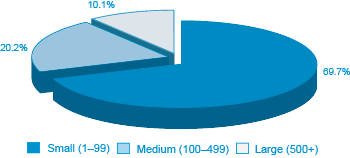
Source: Statistics Canada, Labour Force Survey (LFS), 2012, and calculations by Industry Canada.
Table 4 shows the share of total private employment by business size in each province in 2012. Quebec and Ontario had the lowest share of employees working for SMEs at 87.5 percent and 88.5 percent, respectively, which is below the national average. In contrast, Prince Edward Island had the highest percentage of employees working for SMEs at 94.3 percent, followed by Nova Scotia (94.1 percent) and British Columbia (93.7 percent). Such variations are likely due to the structure of provincial economies. For example, Ontario's economy has many large firms in the manufacturing sector, whereas Prince Edward Island's economy is structured around small businesses.
| Province | Small (1–99) | Medium (100–499) | Large (500+) | Total Employment SMEs | Total Employment all Firms | Employment Related to SMEs (%) |
|---|---|---|---|---|---|---|
| Source: Statistics Canada, Labour Force Survey (LFS), 2012, and calculations by Industry Canada. | ||||||
| All Provinces | 7,745,704 | 2,247,780 | 1,121,025 | 9,993,484 | 11,114,508 | 89.9 |
| Newfoundland and Labrador | 102,982 | 24,535 | 9,921 | 127,518 | 137,439 | 92.8 |
| Prince Edward Island | 33,079 | 5,534 | 2,353 | 38,613 | 40,966 | 94.3 |
| Nova Scotia | 213,442 | 53,539 | 16,606 | 266,981 | 283,587 | 94.1 |
| New Brunswick | 159,525 | 44,902 | 16,653 | 204,427 | 221,080 | 92.5 |
| Quebec | 1,684,396 | 521,702 | 315,724 | 2,206,098 | 2,521,822 | 87.5 |
| Ontario | 2,887,141 | 949,869 | 497,440 | 3,837,010 | 4,334,450 | 88.5 |
| Manitoba | 275,847 | 73,749 | 31,316 | 349,596 | 380,913 | 91.8 |
| Saskatchewan | 231,064 | 50,544 | 20,123 | 281,608 | 301,731 | 93.3 |
| Alberta | 1,053,224 | 262,003 | 118,553 | 1,315,227 | 1,433,780 | 91.7 |
| British Columbia | 1,105,002 | 261,403 | 92,334 | 1,366,406 | 1,458,740 | 93.7 |
The distribution of employment by size of business varies considerably across industries. As shown in Table 5, small businesses account for over 80 percent of employment in four industries: agriculture (90.7 percent), other services (90.6 percent), accommodation and food services (89.6 percent) and construction (81.8 percent). In all industries, at least half of the workforce is employed by small businesses.
| Industrial Sector (Ranked by number of employees in small businesses) | Size of Business (No. of Employees) | Total | ||||
|---|---|---|---|---|---|---|
| 1–19 | 20–99 | Small (1–99) | Medium (100–499) | Large (500+) | ||
| Source: Statistics Canada, Labour Force Survey (LFS), 2012, and calculations by Industry Canada. Industry data are classified in accordance with the North American Industry Classification System (NAICS). Footnote * Goods-producing sector. | ||||||
| Wholesale and Retail Trade | 917,818 | 925,222 | 1,843,039 | 436,704 | 75,474 | 2,355,217 |
| Accommodation and Food Services | 463,138 | 443,329 | 906,468 | 86,264 | 18,960 | 1,011,692 |
| Footnote * referrer Manufacturing | 319,858 | 543,253 | 863,111 | 577,041 | 266,173 | 1,706,325 |
| Footnote * referrer Construction | 443,833 | 279,265 | 723,098 | 119,812 | 41,390 | 884,300 |
| Professional, Scientific and Technical Services | 315,592 | 253,574 | 569,166 | 202,132 | 80,518 | 851,817 |
| Finance, Insurance, Real Estate and Leasing | 291,456 | 234,572 | 526,028 | 159,357 | 150,190 | 835,575 |
| Other Services | 382,453 | 122,789 | 505,242 | 41,474 | 10,776 | 557,492 |
| Health Care and Social Assistance | 263,846 | 220,054 | 483,900 | 190,409 | 199,282 | 873,592 |
| Business, Building and Other Support Services | 226,818 | 159,714 | 386,532 | 87,121 | 35,489 | 509,142 |
| Information, Culture and Recreation | 156,723 | 183,889 | 340,612 | 116,326 | 90,787 | 547,725 |
| Transportation and Warehousing | 143,157 | 180,049 | 323,206 | 139,324 | 80,979 | 543,508 |
| Footnote * referrer Forestry, Fishing, Mining, Quarrying, Oil and Gas | 76,768 | 88,794 | 165,562 | 81,477 | 70,036 | 317,075 |
| Footnote * referrer Agriculture | 83,783 | 25,957 | 109,740 | 10,341 | 969 | 121,050 |
| Percentage in Service-Producing Sector | 77.38 | 74.39 | 75.97 | 64.91 | 66.23 | 72.75 |
| Percentage in Goods-Producing Sector | 22.62 | 25.61 | 24.03 | 35.09 | 33.77 | 27.25 |
| All Industries | 4,085,242 | 3,660,462 | 7,745,704 | 2,247,780 | 1,121,025 | 11,114,508 |
| Percentage of Total Employment | 36.76 | 32.93 | 69.69 | 20.22 | 10.09 | 100.00 |
In terms of the total number of employees, industries that had the largest number of employees working for small firms were, in order of magnitude, wholesale and retail trade (1.84 million), accommodation and food services (0.91 million), manufacturing (0.86 million) and construction (0.72 million). These industries alone accounted for 56.0 percent of all jobs in small businesses in Canada. Overall, industries in the goods-producing sector accounted for 27.3 percent of total employment and 24.0 percent of employment in small businesses.
How many jobs do small businesses create?
Small businesses account for more than 98 percent of all firms in Canada and proportionally play a large role in net job creation, creating 77.7 percent of all private jobs from 2002 to 2012 (Figure 2). In total, small businesses created a little over 100,000 jobs each year on average. Medium-sized and large businesses, which account for 1.6 percent and 0.1 percent of all firms, respectively, created 12.5 percent and 9.8 percent of net new jobs over the same period, representing about 17,000 and 11,800 jobs each year on average.
Figure 2: Percentage of Private Job Creation by Size of Business Establishment, 2002–2012
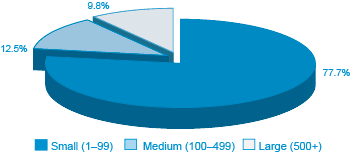
Source: Statistics Canada, Labour Force Survey (LFS), 2012, and calculations by Industry Canada.
Figure 3 displays relative contributions to the net change in paid employment by small, medium-sized and large businesses from 2002 to 2012. The relative contribution varied by year, but small businesses consistently outperformed medium-sized and large businesses in terms of employment growth. Small business job creation ranged from over 192,000 in 2002, to under 15,000 jobs in 2005, to a loss of over 93,000 jobs in 2009. The 2008–2009 recession affected businesses of all sizes, resulting in more job losses in one year than in any other year during the 2002 to 2012 period. More than 336,000 jobs were lost in 2009, with medium-sized firms losing the most jobs at almost 147,000. Since 2010, over 530,000 jobs have been created by businesses of all sizes.
Figure 3: Contribution to Net Change in Private Employment by Size of Business Establishment, 2002–2012
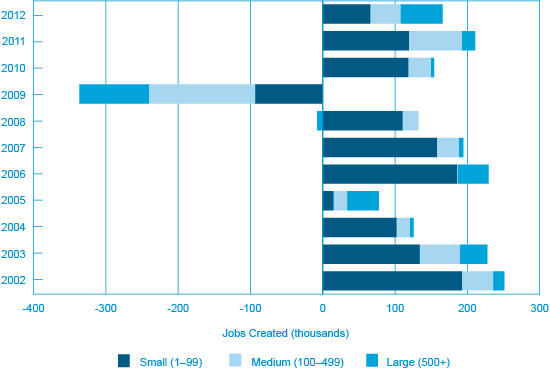
Source: Statistics Canada, Labour Force Survey (LFS), 2012, and calculations by Industry Canada. Historical data are frequently revised and, as of 2000, are available on a North American Industry Classification System (NAICS) basis.
Figure 4 shows the change in employment by business size over time compared with levels in the first quarter of 2008. During the recession (Q4 2008 to Q2 2009) jobs were lost in firms of all sizes, but each firm size has recovered differently. SMEs began to hire again in the third quarter of 2009.
Figure 4: Private Employment by Size of Business, Q1 2008 to Q4 2012

Source: Statistics Canada, Labour Force Survey (LFS), 2012, and calculations by Industry Canada.
There has been an upward trend in small business hiring since the third quarter of 2009 and small business employment has been above pre-recession levels since the beginning of the second quarter of 2010. Employment in medium-sized businesses has been recovering steadily since the fourth quarter of 2009, reaching pre-recession levels in the fourth quarter of 2012. Employment in large firms also fell during the recession and recovered pre-recession levels in the second quarter of 2012.
http://www.ic.gc.ca/eic/site/061.nsf/eng/02806.html#q4How many businesses appear and disappear each year?
Thousands of businesses enter and exit the marketplace throughout the year. Figure 5 shows the number of small businesses that entered and exited the marketplace in 2008 and 2009 and compares the goods and services sectors. During this period, over 150,000 new small businesses were created in Canada. Taking into account exits, the net increase in the number of small businesses was almost 22,000. Of these, 17,200 were in the service-producing sector and 4,500 were in the goods-producing sector. Looking at these two years separately, in 2008 almost 30,000 small businesses were gained, compared with 8,000 lost in 2009. Given the economic conditions in 2008–2009, this pattern of entries and exits is not unexpected.
Figure 5: Entries and Exits of Service-Producing and Goods-Producing Small Businesses, 2008–2009

Source: Statistics Canada, Entrepreneurship Indicators Database, December 2012.
Bankruptcy statistics
Only a small proportion of firms exiting the marketplace end up filing for bankruptcy. On average over the last 14 years, there have been approximately 7,000 business bankruptcies per year in Canada. There were about 3,200 business bankruptcies in 2012, declining from the peak of more than 10,000 in 2001.
More detailed statistics on business bankruptcies and the liabilities involved are available on the website of the Office of the Superintendent of Bankruptcy.
How long do small businesses survive?
One way to answer the question of how long businesses are likely to survive is to determine the probability of survival based on predictable factors. Geographic location, type of industry, size and age are some useful factors in predicting how long a business stays active. Other, unforeseen, factors can also affect the survival of a business, including general economic conditions, as well as market influences such as the number and size of competitors and new entrants.
Survival is defined as the percentage of new firms that continue to operate when they reach a given age. The survival of businesses reflects their productivity, innovation and resourcefulness, as well as their adaptability to changing market conditions.
Figure 6 shows survival rates for all Canadian SMEs with 1 to 499 employees, as well as micro-enterprises (1 to 4 employees) and other small enterprises (5 to 99 employees). The rates represent the percentage of firms that survived until 2009 and were created one to two years prior to that. Of SMEs that entered the marketplace in 2008, 80 percent survived for one year. Other small enterprises have a higher one-year survival rate (85 percent) than micro-enterprises (79 percent). Only 72 percent of SMEs that entered the marketplace in 2007 survived for two years: the lower survival rate is mostly due to the micro-enterprise survival rate falling to 68 percent, while the survival rate for other small businesses remained steady at 86 percent.
Figure 6: Survival Rates of all SMEs, Micro-Enterprises and Other Small Enterprises (Employer Businesses Only), 2007–2009
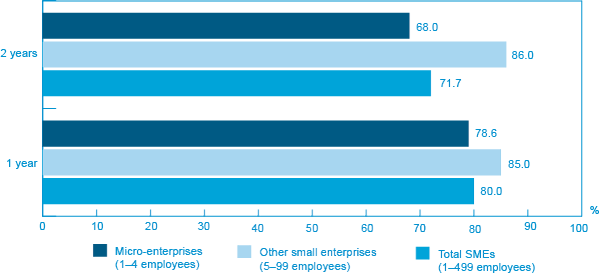
Source: Statistics Canada, Centre for Special Business Projects, December 2012.
What share of firms are high-growth firms?
Firms that achieve high growth in a short period of time tend to make a large contribution in terms of employment and wealth creation. Although high-growth firmsFootnote 5 tend to be associated with innovative high-tech firms, the reality is that they tend to be found across all industrial sectors.
Figure 7 illustrates the percentage of high-growth firms found in each industry between 2006 and 2009 in terms of revenue and employment growth. High growth is more prevalent when defined by revenue compared with employment, with 4.6 percent of all firms being high growth in terms of revenue, but only 3.1 percent in terms of employment. There are high-growth firms in every industry. In 2009, the sectors with the highest percentage of high-growth firms defined in terms of employment were construction (4.9 percent) and business, building and other support services (4.6 percent).
Figure 7: Percentage of High-Growth Firms by Industrial Sector and Definition of Growth, 2006-2009
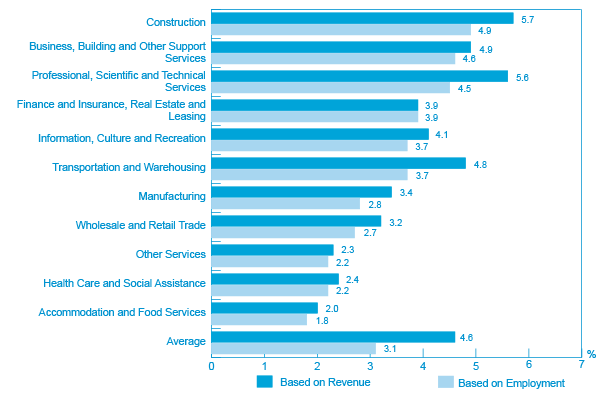
Source: Statistics Canada, Entrepreneurship Indicators Database, December 2012.
Note: Because of comparative statistical rules with OECD countries, the numbers, referring to industries in this figure, exclude agriculture, forestry, fishing and hunting; mining, quarrying, and oil and gas extraction; utilities; and public administration.
Figure 8 shows the share of high-growth firms in Canada and eight other countries in the manufacturing and services sectors in 2008 in terms of employment. In manufacturing, Canada ranked sixth, with 3.3 percent of manufacturing firms being high-growth, between highest-ranked United States (with 5.0 percent high-growth firms) and lowest-ranked Italy (with 2.2 percent high-growth firms). In the services sector, Canada ranked eighth, with 3.2 percent of Canadian firms being high growth, compared with first- and second-ranked Sweden and Hungary (with 5.6 percent and 5.4 percent high-growth firms respectively).
Figure 8: Share of High-Growth Firms (Employment Growth), International Comparisons, 2008

Source: Organisation for Economic Co-operation and Development, Entrepreneurship at a Glance, 2012.
Figure 9 shows the expected yearly average growth in sales/revenues for the 2012–2014 period in manufacturing and service-producing SMEs. Over 50 percent of firms in each sector expect to grow between one and ten percent over the observed period. Manufacturing firms were more optimistic than service-producing firms regarding the possibility of high growth. Nineteen percent of manufacturing firms expect to achieve 11–20 percent growth and 9 percent of firms expect to achieve more than 20 percent growth.
Figure 9: Expected Yearly Average Firms' Growth in Sales/Revenues, 2012–2014
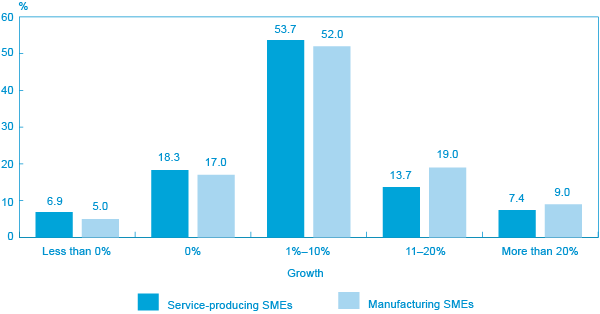
Source: Statistics Canada, Survey on Financing and Growth of Small and Medium Enterprises, 2011.
Note: Service-producing includes information and cultural industries; professional, scientific and technical services; health care and social assistance (excluding out-patient care centres, medical and diagnostic laboratories, other ambulatory health care services, and general medical and surgical hospitals); arts, entertainment and recreation; accommodation and food services; and other services (except public administration).
For more information on high-growth firms, please refer to Growth Map of Canadian Firms, Special Edition: Key Small Business Statistics (January 2010).
How much do small businesses innovate?
In a world with limited resources, the fastest way to boost productivity and economic growth is to innovate. Innovation is often thought to be synonymous with high technology inventions, but innovative behaviour also encompasses many other ways of turning creative ideas into innovations. Statistics Canada's Survey on Financing and Growth of Small and Medium Enterprises, 2011, breaks down innovation into four categories: product, process, organizational and marketing innovations. Results reveal that from 2009 to 2011, 38 percent of small businesses and 56 percent of medium-sized businesses made at least one of these types of innovations.
The availability of resources to spend on research and development (R&D) is tied to the size of businesses. Large businesses account for fewer than 0.2 percent of all employer businesses, but accounted for over 50 percent of all R&D expenditures in 2009 (Figure 10). Small businesses make up 98 percent of all employer businesses, on the other hand, but accounted for only 31 percent of total R&D expenditures.
Figure 10: Percentage of Total Expenditures on R&D by Firm Size, 2009
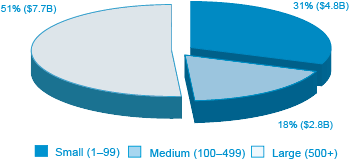
Source: Statistics Canada, Industrial Research and Development: Intentions, 2012, and calculations by Industry Canada.
Figure 11 shows the percentage of SMEs by industry that have innovated within the last three years. The manufacturing industry had the highest percentage of firms innovating (58.1 percent) and transportation and warehousing the lowest percentage of firms innovating (27.5 percent). Other industries with high percentages of firms innovating included knowledge-based industries (50.0 percent); professional, scientific and technical services (43.5 percent); and wholesale and retail trade (41.1 percent).
Figure 11: Percentage of SMEs Innovating within the Last Three Years by Industrial Sector, 2011
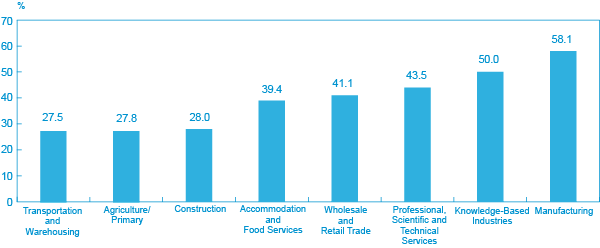
Source: Statistics Canada, Survey on Financing and Growth of Small and Medium Enterprises, 2011, and calculations by Industry Canada.
What is the contribution of small businesses to Canada's exports?
Exporting is vital to Canada's economy, is a driver of economic growth and is strongly correlated with real gross domestic product (GDP) growth. Furthermore, exporting can provide a strategically important means of growing a firm by expanding its market beyond the confines of Canada's relatively small domestic market. Canada's continued commitment to establishing trade agreements reflects this importance.
In 2011, Canadian enterprises of all sizes exported goods with a total value of approximately $374 billion, of which $191 billion were related to manufacturing.Footnote 6 This represents an increase of about $48 billion (15 percent) from 2010. The shares by firm size were 23.9 percent for small businesses, 16.2 percent for medium-sized businesses and 59.9 percent for large businesses respectively.
Exports have accounted for close to 30 percent of GDP in recent years, down from 34 percent prior to 2008.Footnote 7 While the value of exports has not reached pre-recession levels, it increased in 2010 and 2011.
In 2011, about 90 percent of Canadian exporters were small businesses, compared with 85 percent in 2008 and 87 percent in 1999.Footnote 8 It is important to note that, although about 90 percent of exporters are small businesses, only 10.2 percent of these small businesses exported goods or services in 2011, while medium-sized businesses accounted for 34.4 percent (Figure 12). In total, 10.4 percent of SMEs were exporters that year.
Figure 12: Proportion of SMEs that Exported in 2011

Source: Statistics Canada, Survey on Financing and Growth of Small and Medium Enterprises, 2011, and calculations by Industry Canada.
In terms of destinations in 2011, Canadian SMEs disproportionally exported to the United States (89.3 percent) and Europe (32.1 percent) (Table 6). While these two regions figure prominently, exports of Canadian SMEs are remarkably diversified across destinations. Indeed, Asia, including China, and Latin America were noticeable export destinations, receiving 21.1 percent and 11.9 percent of exports respectively. This diversification is more important for the small businesses with 20 to 99 employees as well as for the medium-sized businesses, particularly for Asian and Latin American destinations.
| Business Size (No. of Employees) | United States | Europe | Latin America | China | Other Asia | Other |
|---|---|---|---|---|---|---|
| Source: Statistics Canada, Survey on Financing and Growth of Small and Medium Enterprises, 2011, and calculations by Industry Canada. | ||||||
| All SMEs | 89.3% | 32.1% | 11.9% | 9.5% | 11.6% | 15.4% |
| 1–4 | 87.2% | 28.9% | 9.1% | 7.4% | 11.4% | 14.3% |
| 5–19 | 89.6% | 35.5% | 9.6% | 11.2% | 7.9% | 15.9% |
| 20–99 | 92.2% | 32.2% | 20.3% | 8.8% | 16.9% | 17.4% |
| 100–499 | 94.8% | 30.7% | 21.7% | 19.2% | 26.4% | 10.0% |
Table 7 shows the prominence of the United States as a destination market for all industry sectors, particularly the accommodation and food services (97.9 percent); health care, information and arts (97.3 percent); and transportation and warehousing (96.6 percent) sectors. Export destinations in Europe are also more important, especially for the health care, information and arts sector (64.9 percent). While manufacturing (23.5 percent) leads the way in exports to Latin America, exports from agriculture, forestry and other resource-based industries (25.0 percent) and the wholesale trade sector (19.0 percent) are more significant in other Asian destinations.
| Industrial Sector | United States | Europe | Latin America | China | Other Asia | Other |
|---|---|---|---|---|---|---|
| Source: Statistics Canada, Survey on Financing and Growth of Small and Medium Enterprises, 2011, and calculations by Industry Canada. Note: "X" denotes data that were deemed confidential by Statistics Canada because of the low number of observations. | ||||||
| Agriculture, Forestry, Fishing and Hunting; Mining and Oil and Gas Extraction | 75.4% | 10.4% | 7.6% | 16.7% | 25.0% | 7.3% |
| Construction | 95.6% | x | x | x | x | 0.0% |
| Manufacturing | 91.6% | 33.9% | 23.5% | 9.4% | 13.5% | 14.4% |
| Wholesale Trade | 86.4% | 33.3% | 13.6% | 14.9% | 19.0% | 24.9% |
| Retail Trade | 84.9% | 27.8% | x | x | x | x |
| Transportation and Warehousing | 96.6% | 17.0% | 10.1% | 10.1% | 13.6% | 14.1% |
| Professional, Scientific and Technical Services | 82.9% | 29.7% | 5.3% | 9.1% | 13.8% | 10.4% |
| Accommodation and Food Services | 97.9% | x | x | 0.0% | x | x |
| Other Services | 94.4% | x | x | x | x | x |
| Health Care and Social Assistance; Information and Cultural Industries; Arts, Entertainment and Recreation | 97.3% | 64.9% | 11.6% | 4.5% | x | 33.6% |
For more information on small business exports, please refer to Canadian Small Business Exporters, Special Edition: Key Small Business Statistics (June 2011).
What is the contribution of small businesses to Canada's gross domestic product?
Gross domestic product (GDP) is a key measure of economic production that can be used to compare any two industries' value added, i.e., the value that an industry, through its activities, adds to its inputs. The main advantage of the GDP concept is that it avoids double counting; hence, it is considered superior in gauging economic performance over, for example, revenue, business counts or even employment. Although the studies below expand the scope of the definition of small business to include businesses with no paid employees, the self-employed and indeterminate businesses, these are the only studies available that measure the contribution of small businesses to GDP. Due to the different approaches to measuring GDP, estimates vary greatly.
The Government of British Columbia's Statistical Service (BC Stats) has developed a method to determine the small business contribution to GDP by province using the income-based approach of the System of National Accounts.Footnote 9 Table 8 shows small businesses' contribution to GDP (including public and private sectors) for Canada and each province from 2002 to 2011.
| Province | Contribution to GDP (Percent) | |||||||||
|---|---|---|---|---|---|---|---|---|---|---|
| 2002 | 2003 | 2004 | 2005 | 2006 | 2007 | 2008 | 2009 | 2010 | 2011 | |
| Source: British Columbia's Statistical Service, Small Business Profile 2012: British Columbia. Note 1: In these data, small businesses comprise businesses with fewer than 50 employees, plus those operated by the self-employed with no paid employees. Note 2: Differences between these data and those published in previous versions of Key Small Business Statistics reflect changes to the underlying data on which the numbers are based, as well as a refinement of the methodology used to generate the estimates. | ||||||||||
| Newfoundland and Labrador | 19 | 18 | 21 | 19 | 19 | 18 | 18 | 20 | 19 | 20 |
| Prince Edward Island | 32 | 29 | 31 | 30 | 30 | 29 | 29 | 29 | 26 | 32 |
| Nova Scotia | 26 | 25 | 26 | 25 | 25 | 26 | 25 | 25 | 24 | 23 |
| New Brunswick | 25 | 23 | 25 | 25 | 24 | 25 | 25 | 24 | 23 | 22 |
| Quebec | 27 | 27 | 29 | 30 | 30 | 30 | 31 | 30 | 28 | 27 |
| Ontario | 24 | 23 | 24 | 25 | 26 | 26 | 27 | 26 | 25 | 25 |
| Manitoba | 23 | 24 | 25 | 25 | 26 | 26 | 26 | 26 | 24 | 24 |
| Saskatchewan | 26 | 24 | 29 | 29 | 30 | 32 | 33 | 35 | 30 | 32 |
| Alberta | 28 | 26 | 26 | 27 | 29 | 31 | 31 | 29 | 27 | 27 |
| British Columbia | 28 | 29 | 33 | 33 | 33 | 34 | 34 | 32 | 30 | 29 |
| Canada | 26 | 25 | 27 | 28 | 28 | 29 | 29 | 28 | 27 | 27 |
BC Stats' definition of small business is restricted to businesses with fewer than 50 employees, plus those operated by the self-employed with no paid employees. By this definition, it is estimated that, in 2011, small businesses accounted for approximately 27 percent of Canada's GDP. This level of contribution has remained consistent over the past decade. The contribution to GDP ranges from a low of 20 percent in Newfoundland and Labrador to a high of 32 percent in Saskatchewan and Prince Edward Island. The largest increase in the contribution to GDP occurred in Saskatchewan, where it was 26 percent in 2002 and 32 percent in 2011. The contribution to GDP decreased most in Nova Scotia and New Brunswick, where it fell 3 percent over the period.
In a recent study, Statistics Canada found that, in 2008, small businesses (here defined as those with 1 to 99 employees) accounted for about 41 percent of private sector GDP. In contrast, large businesses accounted for the most, with 48 percent of GDP, and medium-sized businesses the least, with 11 percent of GDP. Of the total economy, small businesses in the private sector accounted for about 30 percent of GDP, while medium-sized and large firms accounted for 9 and 36 percent of GDP respectively. The public sector accounts for the remaining 25 percent.Footnote 10
Figure 13 compares the share of GDP by size of business across different industries in 2008. Small business GDP contributions were highest from agriculture (92.8 percent), health (82.4 percent), other services (81.0 percent) and education (79.1 percent). In contrast, small businesses contributed far less to the GDP from utilities (2.6 percent), mining (8.6 percent), information (10.3 percent) and manufacturing (25.5 percent).
Figure 13: Share of GDP within Industries by Size of Business Establishment, 2008

Source: Statistics Canada, The Growth of Large Firms in Canada, 2008, and calculations by Industry Canada.
How many small business entrepreneurs are women?
Statistics Canada's Survey on Financing and Growth of Small and Medium Enterprises, 2011, distinguishes five types of business ownership based on gender: female-only ownership, majority female, equal partnership between male and female owners, minority female and no female ownership.
Businesses with equal partnerships between male and female owners accounted for 18.2 percent of employer small businesses, while 13.5 percent were solely owned by females and 53.8 percent were solely owned by males (Figure 14). Ownership ratios were different for medium-sized businesses. Female-only ownership accounted for 4.0 percent of all medium-sized businesses and male-only ownership accounted for 66.0 percent of all medium-sized businesses. This indicates that women are more likely to own small businesses than medium-sized businesses.
Figure 14: Business Ownership Gender Distribution by Enterprise Size, 2011

Source: Statistics Canada, Survey on Financing and Growth of Small and Medium Enterprises, 2011, and calculations by Industry Canada.
Accommodation and food services industries have the highest share of businesses that are solely owned by females, at 22.3 percent, whereas businesses in construction have the lowest share, at only 2.9 percent (Figure 15). In the industry aggregate total, at least 50 percent of ownership is held by females in 31 percent of firms.
Figure 15: Business Ownership Distribution by Gender and Industrial Sector, 2011

Source: Statistics Canada, Survey on Financing and Growth of Small and Medium Enterprises, 2011, and calculations by Industry Canada.
What are the age, experience and education levels of small and medium-sized business owners?
Over the 2004 to 2011 period, there was an increase in the age and number of years of experience of Canadian SME owners. Figure 16 shows the age of SME owners in 2004, 2007 and 2011. Since 2004, the percentage of owners under the age of 49 years has decreased. The percentage of owners between 50 and 64 years of age, on the other hand, has increased to the point that this age group now represents almost 50 percent of business owners.
Figure 16: Percentage of SME Owners by Age, 2004, 2007 and 2011
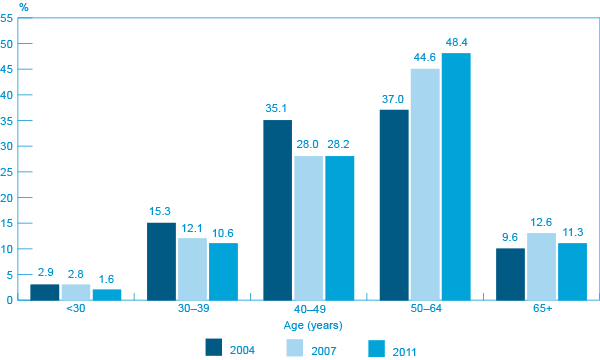
Source: Statistics Canada, Survey on Financing and Growth of Small and Medium Enterprises, 2011; Survey on Financing of Small and Medium Enterprises, 2004 and 2007; and calculations by Industry Canada.
The same trend is occurring with respect to the number of years of experience. As shown in Figure 17, enterprise owners' years of experience have increased from 2004 to 2011, with 77 percent of owners having over ten years of experience in 2011, compared with 69 percent in 2004. In contrast, the percentage of business owners with less than five years of experience fell from 12 percent in 2004 to 5 percent in 2011.
Figure 17: Percentage of SME Owners by Number of Years of Experience, 2004, 2007 and 2011
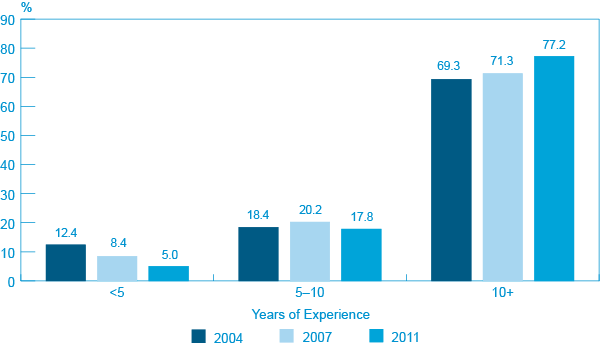
Source: Statistics Canada, Survey on Financing and Growth of Small and Medium Enterprises, 2011; Survey on Financing of Small and Medium Enterprises, 2004 and 2007; and calculations by Industry Canada.
Education levels of business owners vary from less than a high school diploma to a master's degree or above. Figure 18 shows the highest level of education attained by SME owners in 2011. Medium-sized business owners were more likely to have at least a bachelor's degree or above, accounting for 60 percent of all medium-sized business owners. In comparison, the majority of small business owners had a college, CEGEP or trade school education. The data indicate that larger SMEs are more likely to be owned by individuals with higher levels of education.
Figure 18: Highest Level of Education Attained by SME Owners, 2011

Source: Statistics Canada, Survey on Financing and Growth of Small and Medium Enterprises, 2011, and calculations by Industry Canada.
Concluding Remarks
This edition of Key Small Business Statistics has presented key information on the state of SMEs in Canada, such as the population of SMEs, their distribution, their growth performance and details on the characteristics of business owners. More importantly, this information has shed light not only on the similarities and differences that characterize SMEs but also on the importance of SMEs in the Canadian economy.
